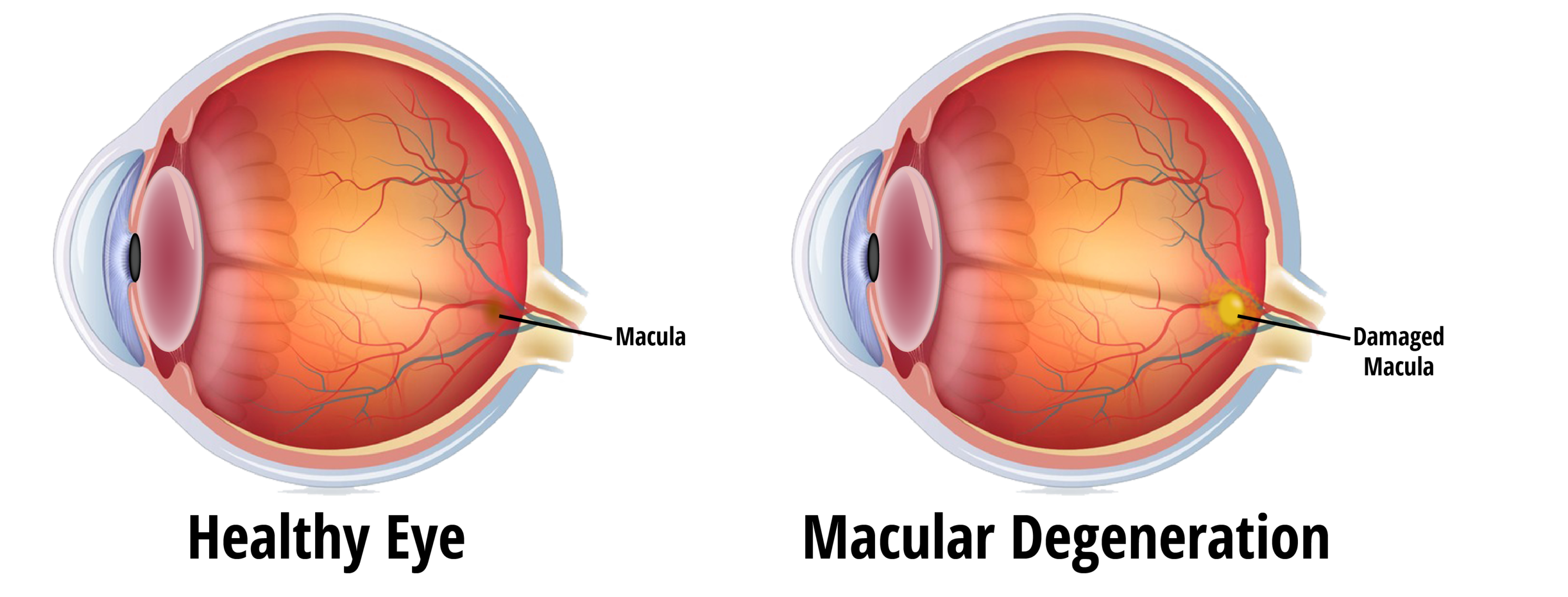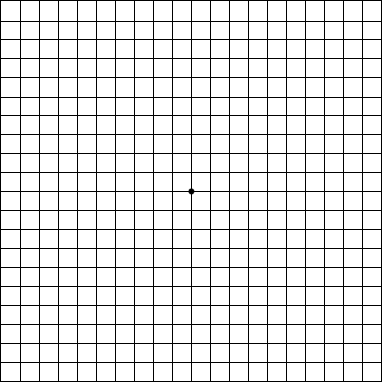What Is Macular Degeneration?
As the name suggests, macular degeneration (or age-related macular degeneration) typically affects the older population (over 60 years) and is currently the most common cause of blindness in this age group.
Risks of developing the disease may include age, genetics, smoking, diet and diabetes, however you aren’t always aware you have the disease. It is therefore important to have regular eye examinations and seek specialist advice at the first signs of the disease.
Is Macular Degeneration Curable?
The current treatment of macular degeneration is to prevent the condition from getting worse. It does not restore lost vision.

What Are My Macular Degeneration Treatment Options?
Treatment will be determined by the type of macular degeneration the patient has developed.
There are two types of macular degeneration (AMD):
Dry
This is a slower, more progressive type of macular degeneration in which the layers of the macula slowly wear down. There is no direct treatment for dry macular degeneration, however in this case, taking antioxidant supplements in conjunction with good diet and exercise can prolong good health of the macula, slow progression and maintain vision.
Wet
This is usually a sequel to dry AMD, where the fluid or blood interferes with the layers of the macula. Wet AMD can cause sudden drops in vision usually requiring intravitreal injections to help reabsorb the fluid and recover vision. This is a very effective and successful treatment of AMD, although many treatments may be required.
Prevention includes antioxidant supplements for the macula and eye health, and a good diet and cessation of smoking. The treatment of age-related macular degeneration may vary depending on the type and extent of macular degeneration you have. Our doctors are specialized in diagnosing, treating and monitoring the progression of macular degeneration, so feel free to ask any further questions you might have when we see you at your appointment.
The best warning system for detecting macular degeneration is the Amsler Grid, as this disorder can lead to reduction and distortion of vision. The Amsler Grid can be obtained from your eye specialist.
The Amsler Grid should not be relied upon for diagnosis – it is merely a tool to test for and monitor symptoms of macular degeneration (AMD).

How to test with Amsler Grid:
- If you normally wear reading glasses, do not remove them.
- Sit approximately 14 to 16 inches away (or normal reading distance) from the screen, with the grid at eye level.
- Cover the left eye.
- With the right eye, focus on the dot in the center of the grid.
- While focusing on the dot, be aware of the lines of the grid.
- Now, cover the right eye and repeat the test.
- Be aware of the surrounding squares and assess whether there are dark spots in your vision, bent lines, big squares or small squares (see example).
- You should immediately report any of these positive findings to your EyeCare Associates of South Tulsa specialist.
Meet Your Doctor

Dan Langley, D.O., F.A.O.C.O.
Board Certified Ophthalmic Surgeon
An internationally recognized ophthalmology fellow and expert in modern cataract surgery. He is a board-certified ophthalmologist, specializing in cataract surgery, lens implants, and refractive surgeries such as laser-assisted in situ keratomileusis (LASIK) and dysfunctional lens syndrome (DLS). Certified on the wavelight refractive suite, he performs the “Custom Bladeless LASIK” procedure and is also uniquely trained in surgical treatments for glaucoma and presbyopia. Always at the forefront of innovation, Dr. Langley is one of the first surgeons in Oklahoma to use Dropless,an injectable formulation (Tri-Moxi) administered during cataract surgery to reduce or eliminate the need for drops after cataract surgery. He was the first doctor in Eastern Oklahoma to use the Glaukos iStent for treating glaucoma and one of the first using the Symfony intraocular lens (IOL) for cataract lens replacement.
Originally from Edmonds, Washington, Dr. Langley graduated Cum Laude from Washington State University where he played football and was an active member of the Theta Chi Fraternity. In 2002, Dr. Langley graduated from Des Moines University College of Osteopathic Medicine and Surgery and then completed his ophthalmology training in Tulsa, Oklahoma. During his residency Dr. Langley earned awards for excellence in refractive and cataract surgery from Oklahoma State University’s Department of Surgery. Upon completion of his residency Dr. Langley also received the Lifelong Education award from the American Academy of Ophthalmology and a Physician’s Recognition Award from the American Medical Association. Dr Langley is also currently rated as one of the top ophthalmologists in the nation on Healthgrades.
Previously he was Assistant Professor of Surgery and Clinical Director for the Department of Ophthalmology for the OSU Medical Center where he trained ophthalmology residents. His passion for restoring eye health does not stop there, Dr. Langley spent 5 years as one of the lead surgeons for a medical mission trip to Piura, Peru performing hundreds of surgical procedures for the Peruvian Catholic community.
An internationally recognized ophthalmology fellow and expert in modern cataract surgery. He is a board-certified ophthalmologist, specializing in cataract surgery, lens implants, and refractive surgeries such as laser-assisted in situ keratomileusis (LASIK) and dysfunctional lens syndrome (DLS). Certified on the wavelight refractive suite, he performs the “Custom Bladeless LASIK” procedure and is also uniquely trained in surgical treatments for glaucoma and presbyopia. Always at the forefront of innovation, Dr. Langley is one of the first surgeons in Oklahoma to use Dropless,an injectable formulation (Tri-Moxi) administered during cataract surgery to reduce or eliminate the need for drops after cataract surgery. He was the first doctor in Eastern Oklahoma to use the Glaukos iStent for treating glaucoma and one of the first using the Symfony intraocular lens (IOL) for cataract lens replacement.
Originally from Edmonds, Washington, Dr. Langley graduated Cum Laude from Washington State University where he played football and was an active member of the Theta Chi Fraternity. In 2002, Dr. Langley graduated from Des Moines University College of Osteopathic Medicine and Surgery and then completed his ophthalmology training in Tulsa, Oklahoma. During his residency Dr. Langley earned awards for excellence in refractive and cataract surgery from Oklahoma State University’s Department of Surgery. Upon completion of his residency Dr. Langley also received the Lifelong Education award from the American Academy of Ophthalmology and a Physician’s Recognition Award from the American Medical Association. Dr Langley is also currently rated as one of the top ophthalmologists in the nation on Healthgrades.
Previously he was Assistant Professor of Surgery and Clinical Director for the Department of Ophthalmology for the OSU Medical Center where he trained ophthalmology residents. His passion for restoring eye health does not stop there, Dr. Langley spent 5 years as one of the lead surgeons for a medical mission trip to Piura, Peru performing hundreds of surgical procedures for the Peruvian Catholic community.

